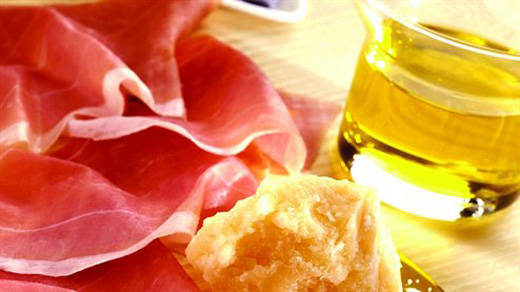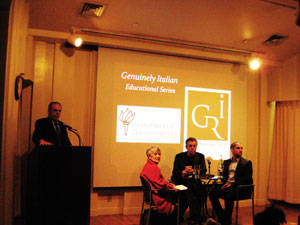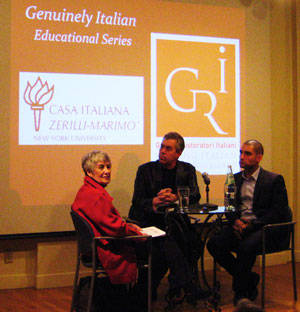"Genuinely Italian". The Pleasure of Food
Flakes of tasty Parmigiano Reggiano, Gorgonzola, ham, olive oil bruschette and stuffed tomatoes, sided by great wine, white and red. It isn't the description of a farmer's feast in the Romagna planes, but a culinary event organized and promoted by GRI, the Gruppo Ristoratori Italiani, in partnership with Casa Italiana Zerilli-Marimò in New York.
Special guests in the auditorium of the old building overlooking West 12th Street in Greenwich Village were Lou Di Palo, owner of DiPalo’s Fine Foods in Little Italy and Louis Coluccio, Jr. from Coluccio & Son in Brooklyn, two of the best known vendors of Italian specialties in New York.
They were interviewed by Michele Scicolone, i-Italy Food Editor and Blogger as well as author of many successful books about gastronomy. The latest is The Italian Slow Cooker, which has been a bestseller for weeks. Among other things she curated the sixty-fifth edition of Joy of Cooking, one of the most sold cooking manuals in America.
The meeting was intended to inform the American public on cooking, but also on the authenticity of the Italian products sold in the Big Apple. The event was embellished by a delicious rich buffet set up by the organizers.
Scicolone, who lately has been concentrating on the bad habits of American consumers and the importance of eating healthily and slowly, avoiding fast foods, served as moderator at the well-attended discussion, answering questions from the public and dialoguing with the two speakers, experts of the food sector and very well prepared on the origin of products made in Italy.
“When I speak about slow food, I mean giving the right importance to alimentation, to the pleasure of food, learning to enjoy recipes and the diversity of tastes” said the author. The event is part of a larger cycle of seminars centered on the preservation of the Italian gastronomical tradition in America, to save it from the success which inevitably led to an increase in forgeries. This phenomenon is ever rising and many people try to cleverly speculate on the notoriety of such a consolidated myth.
“Let's buy our products directly from Italy” said Lou Di Palo “so we can offer a better promise of quality to our clients”. Most of the merchandise distributed by the two shopkeepers is imported, and is obviously subjected to many quality checks before being marketed. The only exception is constituted by the buffalo mozzarella, made here with a technique passed on from generation to generation. The tasty cheese, typical of the Campania region, is kneaded and spun by Lou Di Palo's collaborators, who use exclusively buffalo milk.
Yet it's impossible to maintain the original denomination mozzarella di bufala campana, since the milk comes from other farms.
And perhaps the final product will never have the classic pearly color or the smooth and shiny surface of the famous 'bocconcini', but the taste is similar: sweet at the tip of the tongue, salty and slightly acidulous at the edges.
“Recognizing the variety of the production areas and of the makers is fundamentally important” added Scicolone. According to the gastronomy expert, the education to taste can become a great defense mechanism against fraud, bad quality and homologation.
Food biodiversity and sovereignty are therefore the key words within a complex debate that retraces all of the production's steps; from the picking of the San Marzano tomatoes in the fields, to the intermediation of the wholesalers, up to the final step in the shopkeeper's store.
The meeting – which had the objective of spreading the knowledge of authentic and refined Italian cuisine through visibility and credibility - set up by GRI, a non-profit organization founded in 1979 and made up of the greatest Italian restaurateurs on American territory, was successful.
The truthfulness of the statements is assured by the quality of the sold food and by the constant flow of information that accompanies the product when purchased.
In this case the audience, curious and avid of knowledge, had to do with a small taste of the small delicacies, of the flow of interview and answers and the many questions from the public. “How do you preserve buffalo mozzarella?” “How do you cook pasta with cuttlefish ink?” are just two of the questions.
But it was Pizza, the most famous Italian dish, known and loved internationally, that caused the largest debate. When someone artlessly asked “what's the difference between the cheese on a 99c pizza and regular mozzarella?”, a cloud of dust rose from the public. “Mozzarella doesn't melt completely and doesn't reach a homogenous shape, like the cheese mostly used in America. Cheese cannot be considered a substitutable ingredient” said Louis Coluccio, almost indignant.






































i-Italy
Facebook
Google+
This work may not be reproduced, in whole or in part, without prior written permission.
Questo lavoro non può essere riprodotto, in tutto o in parte, senza permesso scritto.